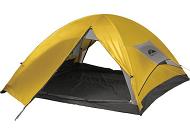What About Backpacking Tents?
Are backpacking tents necessary? It’s a question we get asked a lot. The answer depends on the type of backpacking trip you are taking and personal preference. Many backpacking trips last multiple days and require some sort of shelter for the night. There are a few options for this shelter – the two most common being a tent and a tarp. Both have pros and cons. On this page, we’ll focus on tents. For the sake of remaining lightweight, some backpackers choose to bring tarps in order to create a freestanding shelter.
If you’re interested in learning more about using tarps for shelter, visit our page on backpacking tarps.
Types of TentsTents come in all shapes and sizes. They also are followed by many different terms. It can all be a bit confusing. Here is some general information to help understand what you’re looking at when buying a tent. Size Rating. Tents are rated by how many people they can hold. Generally, it is best to buy a size bigger than the amount of people you need to hold in order to have a proper place to store your gear. A 2 person backpacking tent will be cramped for two people and their equipment. Here are some tips on finding a good 2 person tent. (Coming Soon!) Season Rating. Tents are also rated by season. Most tents are 3 season tents, meaning they will work well in all seasons but winter. 4 season tents are designed to withstand snow, wind and cold temperatures.
For more information on the 4 season tent, check out our page on them.
Unless you are planning a winter or Alpine backpacking trip, a 3 season tent will be suitable for your needs. There are convertible tents that can be both a 3 season and a 4 season tent depending on how you set it up. Additional Tips- A term you might commonly come across is “freestanding.” This means the tent does not require to be staked in order to stay up. Many backpackers prefer freestanding tents because of the ease of setting up and the versatility of use on different terrains.
- In general, you want to choose a tent that can be stored in a small, compact sack.
- You want a backpacking tent that is easy to set up and take down. Sometimes, you find yourself in need to being able to set up camp quickly and you don’t want to mess with a tent that’s a pain to put together.
- As mentioned above, a tent can add several pounds to your pack, so try to find a tent that weighs six pounds or less.
If you’re interested in backpacking light, check out our page on the ultralight tent.
- To help protect your tent, bring a footprint or a tarp to place under the tent. This will prevent damage from debris on the ground.

- If you want to shave a few pounds and go for the smaller backpacking tent, it’s good to look into the option of a vestibule – a tarp-like addition that makes an enclosed overhang for storing gear outside of the tent, but still protecting it from the elements.
- To further cut weight, make sure your tent poles are made out of aluminum as opposed to fiberglass. Aluminum poles are stronger and lighter than their fiberglass counterparts.
- Finally, when purchasing a tent, remember to buy quality. This will affect how long it lasts and how well it shelters you from elements. Quality backpacking tents are well worth paying a little more.
Return from Backpacking Tents to Backpacking Tips Home Page
|






